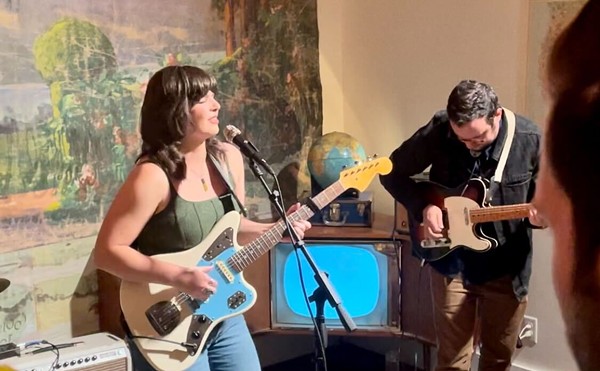No doubt each of these warblers would claim Hank Williams as an important influence on his or her music. In fact, Jackson offers just such a testimonial in the booklet that accompanies The Complete Hank Williams, a just-issued 10-CD set on the Mercury imprint: He claims that he and songwriter Don Sampson penned the ditty "Midnight in Montgomery" after visiting Williams' Alabama grave, adding, "Most people, in or out of country music, are fans of Hank's and consider him a legend -- which he is." But although such boosters recognize Williams as an important historical figure, too many of them seem to feel that his tunes no longer speak to contemporary listeners. To them, his music is too raw, his voice too nasal and his approach too unvarnished for their liking. If they must hear a Williams, they'd prefer it be Hank Jr. belting out the question "Are you ready for some football?"
But the elder Williams' achievements are far too vital to be studied and set aside like some musty volume by Chaucer that's been loathed by generations of literature pupils. The singer was only 29 when he was found dead in the backseat of his powder-blue Cadillac on New Year's Day of 1953, and the span between his first studio session and his last was less than six years -- yet during that period, he still managed to create a country catalog that hasn't been topped to this day. The boxed set (issued to commemorate what would have been his 75th birthday) supplements his main body of recordings, which fill the first four discs, with a variety of demos and tapes from concerts and appearances for radio or television that vary in import and sound quality. But viewed as a whole, the package is both half-a-day's worth of pure pleasure and an eloquent argument against the slickness and superficiality that's running rampant in the genre that Williams all but defined five decades ago.
If Williams were a new artist now, he probably wouldn't get past a major label's reception desk. After all, he wasn't pretty (his ears recall those of the banjo-playing boy in Deliverance); he was in poor health (he had chronic back problems); he was deeply unstable (a typical problem when you're hooked on drugs and liquor); and he tended to sing about love and death as if there weren't that much difference between them. But he was also blessed with the ability to translate his deepest joys and fears into song, and the passage of time has done nothing to dull his work's power or lessen its significance. There's no music more American than his, and to understand the man who made it is to get a handle on the land from which he sprang.
Williams' childhood was a model of dysfunctionality -- perfect for a country tunesmith. He was born Hiriam King Williams in 1923 in Mount Olive, a tiny community in rural Alabama, to Lillie Williams, a bulldozer of a woman, and her husband, Lon, a disabled World War I veteran in such desperate shape that he took up permanent residence in a VA hospital when his son was 6 years old. Young Hiriam had a sister, Irene, but Lillie focused the lion's share of her energy on him, particularly after he began to display a talent for music. He learned how to play the guitar from Rufus Payne, a black busker known as Tee-Tot; in the boxed set's booklet, essayist Daniel Cooper quotes Williams as saying that he shined shoes in order to afford the lessons. Soon Hiriam was crooning for coins on street corners, too, and by the time he reached the age of 17, he was appearing as the "Singing Kid" on WSFA, a Montgomery radio station. By all accounts, he was already wild (his blood-alcohol level was rarely at zero), and his wandering ways didn't end when, in 1943, he met Audrey Sheppard Guy, a looker with a 2-year-old daughter, Lycrecia, from a previous marriage. Audrey and Hank, as he was known by then, were a volatile match: Her Lillie-like ambition and drive alternately attracted and repelled him, prompting just as many loving reunions as horrible scraps. During the next nine years they would marry, divorce, remarry and divorce again.
While performing, Williams could be just as erratic. In Hank Williams: The Biography, author Colin Escott, who provides the first-rate notes for the box, recounts a 1943 turn at which a drunken Williams was asked to introduce emcee Hardrock Gunter. Instead, he grabbed Gunter's guitar, charged onstage and played several unscheduled songs -- and the only thing that prevented him from walking away with the instrument after he'd finished was his inability to get through a doorway with it slung over his shoulder (he tried twice before Gunter stopped him). But even though he was stewed to the gills, he still wowed the crowd. This ability served him in good stead later, when he was seldom far from a bottle.
Fred Rose provided Williams' big break. The co-owner of Acuff-Rose Publishing, a firm that partnered him with Nashville pioneer Roy Acuff, Rose championed the songwriter to the small Sterling imprint, which signed him in 1946. Williams cut his first songs for the company late that year and early the next, and the results neatly symbolized the elements at war within the bony savant. "Calling You," the first track on Complete, is a string-heavy ditty in which the hellraiser piously wonders, "When you stray from the fold/And there's trouble in your soul/Can't you hear the blessed Savior calling you?" But such remorse doesn't keep Williams on the straight-and-narrow: "My Love for You (Has Turned to Hate)" is mighty short on Christian forgiveness ("Don't come back now/It is too late/My love for you has turned to hate"), and the exuberant, irresistible "Honky Tonkin'" casts Hank as eager adulterer ("When you and your baby/Have a fallin' out/Call me up, sweet mama/And we'll go steppin' out").
Musically, these tunes aren't especially original: According to Escott, the melody of "Calling You" bears more than a passing resemblance to a J.M. Henson hymn, and "Pan American," a paean to a train Williams knew from his youth, isn't exactly dissimilar from "Wabash Cannonball." Likewise, the arrangements, built on simple clip-clop rhythms, a strummed acoustic guitar and tasty filigree provided by electric guitars, steel guitars or fiddles, don't set new standards for the style. But what makes them stand out is Williams' sure feel for hooks, his deceptively versatile, straight-through-the-nose vocal delivery and his peerless ability as a phrasemaker. From "Hey, Good Lookin'" to "Your Cheatin' Heart," the contemporary lexicon is filled with expressions that passed Williams' lips first.
After Williams moved from Sterling to MGM, "Move It on Over," a bouncy tale from the doghouse that's still a bar-band staple, became his first legitimate chart smash, and its success eventually led to his being added to the cast of Louisiana Hayride, a popular radio variety program. But he was capable of hitting far more than that one note. Also laid down during 1947 were "I Saw the Light," a gospel spine-tingler with just a hint of creepiness ("Then Jesus came like a stranger in the night/Praise the Lord, I saw the light!"), the rowdy "I'm a Long Gone Daddy" and "Mansion on the Hill," an assignment from Rose -- he wanted Williams to practice narrative writing -- that turns on gothic imagery that would have done Daphne du Maurier proud. As for "Lovesick Blues," the platter that made Williams a star, it's a cover of a 1922 show tune that's highlighted by some of the finest country yodeling ever caught by a microphone.
Of course, any true Williams fan already knows these numbers backward and forward -- and the same can be said about "I'm So Lonesome I Could Cry," "Lost Highway," "My Bucket's Got a Hole in It," "Cold, Cold Heart," "I'll Never Get Out of This World Alive" and "Jambalaya (on the Bayou)," all of which appear on Complete in pristine remastered form. But the project's chronological construction allows even longtime acolytes to hear tracks with fresh ears. The four songs on Disc 2 on which Hank duets with Audrey say all that needs to be said about their discordant relationship, as author Escott suggests; she's actually louder than he is and makes no apparent effort to harmonize with him. "My Son Calls Another Man Daddy" can't be described as seminal, either -- it's a minor bit of cornpone -- but Williams' fruity, throbbing vocals sell both of the versions that appear on the second CD. Even more striking is "The Funeral," a recitation of a poem from 1909 that Williams issued under the pseudonym Luke the Drifter. The words are patronizingly bigoted: Williams laments the death of "a little colored kid" with "curly hair" and "protruding lips" whose service is overseen by a preacher whose "Ethiopian face showed the wisdom and ignorance of a crushed, undying race." But damn it if the singer, backed by a melodramatic organ, isn't able to make the most out of every ounce of sap.
Complete discs 5 through 10 are not nearly as seamless as those that precede them, but they sport more than their share of treasures. Included is a trio of primitive recordings of Hank as a teenager (he renders "Happy Rovin' Cowboy," "Freight Train Blues" and "San Antonio Rose"); a strong batch of demos made in Shreveport, La., during the late '40s; some examples of his song-pitching techniques; and, at the conclusion of the final CD, "The Apology," a 1951 tape in which Williams explains to an audience in Washington, D.C., why he was unable to appear at a show scheduled to take place there. In it, he cites a painful operation he had recently endured, but he fails to mention that he fired a shot at Audrey while packing for the trip, prompting her to leave him for the final time.
The year or so after Williams recorded this mea culpa was just as tumultuous. He was in agony from his back problems, and the combination of booze and the painkillers he consumed to deal with his ailment made him even crazier than usual. The Grand Ole Opry, which had made him part of the country-music elite in 1949 on the heels of "Lovesick Blues," unceremoniously canned him three years later because of his unreliability. Moreover, he couldn't get Audrey out of his head. He carried on as usual, impregnating a woman named Bobbie Jett (she gave birth to a daughter, Cathy "Jett" Williams, two days after he was buried) and marrying the strikingly gorgeous Billie Jean Jones Eshliman that fall. (Eshliman left country singer Faron Young for Hank and subsequently married Johnny "North to Alaska" Horton, who made her a widow for the second time when he perished in a 1960 car accident.) But when it came time for his final ride, Williams was ready to go -- ready to see the light.
If the current crop of country luminaries are grappling with such demons, they certainly haven't let on: Jackson, Twain and Brooks may sing about tragedies on occasion, but only rarely, and when they do they don't even pretend that they're referring to themselves. But Williams was. Complete makes it clear that his life and his art were indistinguishable. He didn't die for country music's sins; he had more than enough of his own, thank you. But he set a standard for honesty and truth-telling that precious few of his successors are even trying to equal.
That's a tragedy worthy of a country song. Too bad Hank's not around to write it.





